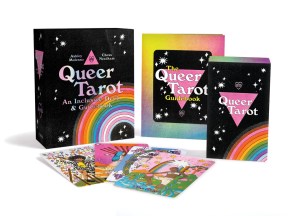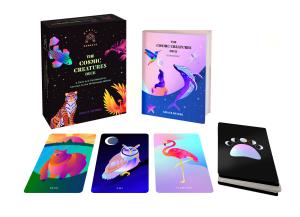Meet the Creators: Ash + Chess of Queer Tarot, Interviewed by Grace Duong of Mystic Mondays
Ash and Chess, creators of Queer Tarot, speak with Grace Duong of Mystic Mondays and the new Cosmic Creatures Deck, about their background in tarot and the creative process behind their new deck and guidebook which celebrates LGBTQ+ identity.
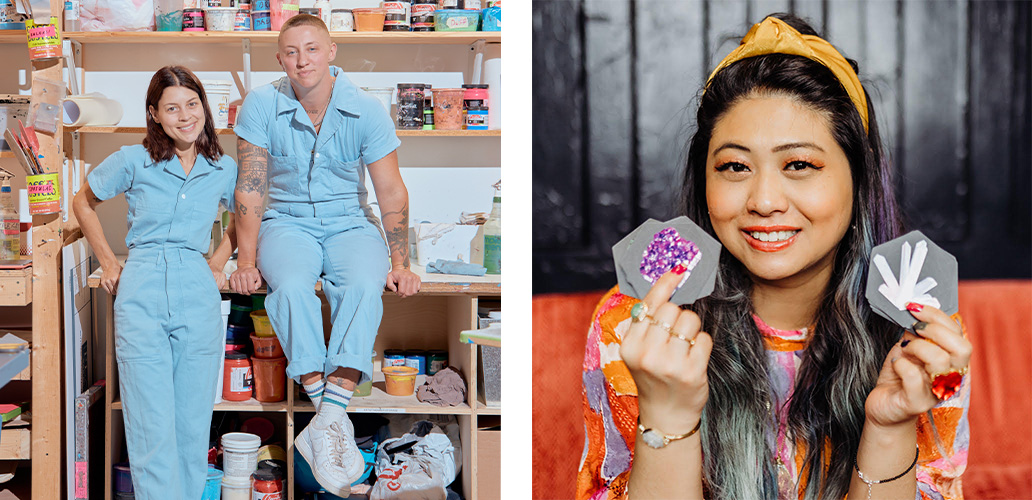
Grace Duong: What inspired you to create Queer Tarot?
Ash: Since Junior High, I’ve been enamored by tarot deck artwork. However, while I admired it from afar, I never actually took the leap to learn about tarot and what all the cards meant. It seemed too overwhelming, and at the time I was surrounded by the preconceived notions of church members that tarot was equivalent to the devil—no questions asked. So, like anyone afraid of the truth, I essentially waited until I was fully detached from what was keeping me from learning tarot, that being the religion (Southern Baptist Christianity) I was brought up in, to dive in. With that out of the way, drawing my own deck became a clearer and more seemingly attainable dream.
Queer Tarot was born out of the idea that, yes, while there were a few decks available on the market that we liked, there wasn’t the one we wanted to make, which was a tarot deck chock full of as many queer identities, abilities, races, ethnicities, and sexualities as we could fit. Looking at the Smith-Rider-Waite tarot deck, which inspired me so much as a teenager, I saw that while this deck is one of the most popular of its kind, it is the least representative of today’s world. With the help from our dear agent and friend Meg, we came up with the idea of making a fully queer and representational tarot deck.

GD: What is it like to collaborate on this tarot deck together? Do you two split the work up or is it a co-creation process of writing and illustrating?
Ash: Each project we work on is completely different when it comes to splitting the workload between us. For Queer Tarot, we did model sourcing and spent time coloring and prepping files to be printed on the risograph together. I worked on most of the outlines for the artwork and printed most of the deck, fitting two cards onto a sheet of paper, printing about 4-5 colors per page. Aside from collaborating with each other on the deck, we also outsourced some of the risograph printing from a fellow studio mate, Alex Luciano, who helped print a lot of the cover artwork and some of the cards for us. As for the guidebook, Chess and I worked on descriptions together. Then we collaborated with our dear friend Amber Berkins who provided further perspective on each card description, as well as the re-verse of the cards which we weren’t as well-versed in.
Starting out, I was afraid and overwhelmed at taking on such a complex and vast practice. However, when our friend Amber did my first reading, I got to experience the inner workings of tarot reading and what it can do. Shortly after she read my cards, Chess and I attended a workshop hosted by Kim Krans, creator of The Wild Unknown Tarot Deck. She introduced tarot as something not to fear, but something to embrace and to learn from, to help in healing of any kind. I bought my first deck there and finally took the leap in committing to learning about tarot.
Chess: My relationship to tarot before working on the project was just tidbits here and there, mostly from what I knew from my friend Amber. I’ve always been a cynic (New Yorker…), and I was always one foot in, one foot out on anything to do with spirituality. But after working on the guidebook and doing countless readings, I started to understand the value of tarot. For me, it’s all about introspection, which is so important. I realized that I already practiced a lot of the teachings of tarot, like reflection, questioning, and digging deeper; but tarot gives a more tangible prompt and scope when you need to gain insight into something.
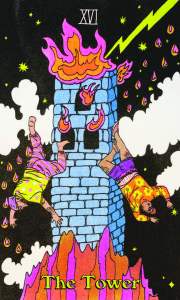
GD: Tarot decks are said to have their own personality. How would you describe Queer Tarot‘s?
Ash: Well, I would hope that this is true—that our deck embodies the big, colorful, and beautiful queer community, that it embodies every single person we were able to cast in the deck. This is a hard question because when I look at the deck and hold the whole set in my hand, each piece was designed to be cohesive with each other, and somehow, all the people that are featured in this deck all look so perfect together. I think maybe this deck possibly reflects “queer utopia.”
Chess: I agree with Ash. Hopefully this deck shows a true vision of what a diverse and beautiful community looks like. I think our deck’s personality is bright, hopeful, and honest.
GD: What did you enjoy most about creating Queer Tarot?
Chess: Involving the community in this project was definitely a highlight. We put out a casting call and got SO MUCH interest—much more than we ever expected.
Ash: Yeah, definitely the casting part. Chess and I would open emails each night during the casting call sessions and almost cry at how special and cute all the queers were! The hardest part was choosing who made it into the deck because honestly, we wanted to use every single person. I was so psyched to include as many people as possible that I almost forgot to leave spots for me and Chess in the deck. The spots we ended up posing for were in the background of the Six of Wands with Cassie Carrasco (she/they). The second most exciting part was printing everything on the risograph and seeing the artwork come to life in fluorescent inks!
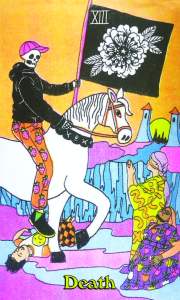
GD: As someone who participated in your call for representation (spot me in the Death card!), what made you decide to open it up for other people to participate and be represented in your deck?
Chess: We wanted real people to participate because the entire aim of the deck is to represent our community, and what better way to do so? We could have drawn imaginary people, of course, but it just seemed so much more impactful to use real models.
Ash: Chess couldn’t have said it better. Using real people that exist in the community rather than using just a few select models repeatedly just really was the way to do it. It didn’t make sense not to include the actual community.
GD: What is your favorite card from Queer Tarot and why?
Chess: I like The Tower. I’m a pretty anxious person and it reminds me that things change suddenly, oftentimes completely out of your control, but that change can be the start of something new. It’s a good reminder that change is inevitable and can appear in many different shapes and forms.
Ash: Meaning-wise, my favorite might just be the Eight of Swords, modeled by Camille Leon (aka Allison Carvalho; she/her), depicting a person tied up and blindfolded among eight propped up swords in a wild, otherworldly landscape. I often jump back to this card when I am feeling stuck or am having trouble decision-making. It is meant to show that maybe it is you who is holding yourself back from moving forward, and that you are the one in control. The binding and the blindfolding can indicate you not wanting to face the truth. I like this one because it reminds me to try to take a step back and analyze. It helps put into perspective that sometimes, I am thinking in a way or doing what I think other people expect of me.
A vibrant, deluxe illustrated tarot deck and guidebook set, centering and celebrating LGBTQ+ identity, created by queer and trans artist team Ash + Chess.
From the artist behind Mystic Mondays comes a deluxe animal spirit deck and guidebook set, featuring vibrant, celestial illustrations and divine information on 66 cosmic creatures.





